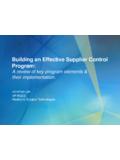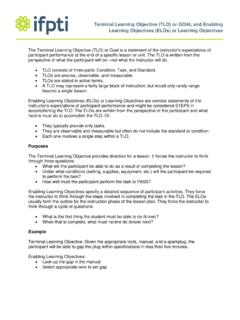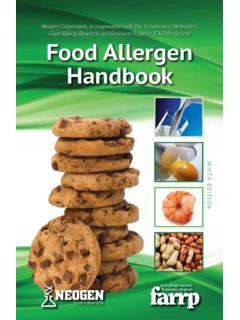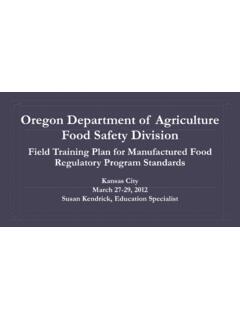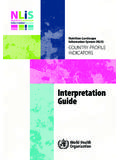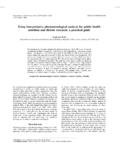Transcription of Swabbing Zones, Understanding Zones and Interpretation …
1 Swabbing Zones , Understanding Zones and Interpretation of Data Don L. Zink, Center for Food Safety and Applied nutrition Food and Drug Administration College Park, MD. The Zone Concept Based on the vulnerability of a RTE food that is exposed to the food production environment Zone 1 is the most sensitive to contamination Zone 3 is the least 1. sensitive to contamination 2. Zone 2 is somewhere in 3. between 1 and 2. The Zone Concept Zones are defined based on the probability of product contamination if a pathogen were to be present in the zone In order to define and identify Zones , you must think in terms of pathways to product contamination Zone 1 is easy to define, but Zones 2 and 3 are defined conceptually.
2 Not by a rigid physical description The Zone Concept Zone 1 is a food contact surface Zone 2 is an area that if contaminated with a pathogen there is a likelihood that zone 1 could become contaminated by the actions of human or machine Zone 3 is an area that if contaminated with a pathogen there is a likelihood that zone 2 could become contaminated by the actions of human or machine The Zone Concept Zone 1 is the surface of a conveyor that transports un-packaged food, a table top where food is handled, the interior surfaces of a pipe that transports food, the interior surfaces of a mixing vessel, a filler nozzle, the interior of a storage bin, the surface of a cooling rack and utensils used to handle food The Zone Concept Zone 2 can be the floor near a piece of equipment where food is exposed, it can be on a piece of equipment that over hangs exposed food, it is usually an area in the same room as zone 1 areas.
3 The Zone Concept Zone 3 is a warehouse where food is enclosed in a package, an employee locker room, a loading dock, a restroom, a hallway outside a room where food is produced. It is rarely in the same room as food production. The Zone Concept Probability of product contamination: Zone 1 a pathogen in this zone is certain to contaminate product Zone 2 a pathogen in this zone will not contaminate product without some help from workers, machinery, water usage or air currents Zone 3 a pathogen in this zone has no chance of contaminating product but could get into Zones 1 or 2. with some help from workers, machinery, water usage or air currents The Zone Concept Originally developed for Salmonella control but now also applied to Listeria These two pathogens differ greatly in their habitats and this causes confusion: When Swabbing for Salmonella, zone 1 is usually a waste of effort, focus on Zones 2 and 3.
4 When Swabbing for Listeria, zone 1 is often productive, focus on Zones 1 and 2. But use intuition, observation and common sense! Salmonella Hunting You must understand your quarry if you expect to be successful Environmental Swabbing Strategies Survey the facility and plan your sampling mission start in the cleanest area Document every sample by photo or diagram with notes on possible path to product contamination Get as much sample or sample area as possible Overkill is good In the Laboratory Process all samples ASAP, ideally within 24 hours of collection Be aware of the possibility of atypical isolates.
5 Particularly for Salmonella in dairy environments PFGE or more sophisticated typing of isolates must be done ASAP strain differences and similarities tell the story PFGE Patterns of Peanut Butter Outbreak Isolates*. Dice ( ) (Tol ) (H> S> ) [ ]. PFGE-XbaI PFGE-XbaI. 100. 95. 411259 Peanut Butter 411260 Peanut Butter 411524 1-1 Peanut Butter 366081-5 Environmental Swab 389113-5 Environmental Swab 409792 Peanut Butter 325732 Peanut Butter 404036 Peanut Butter 411504 Peanut Butter 410573 Peanut Butter 410578 Peanut Butter 410958 Peanut Butter 410967 Peanut Butter 411524 2-1 Peanut Butter *Slide provided courtesy of Christine Keys, FDA-CFSAN.
6 Peanut Butter Salmonella Isolates*. 3 Different, but related PFGE patterns were linked to the same product XbaI Primary Enzyme BlnI Secondary Enzyme #1. #2. #3. Patient A Patient B Peanut Butter #1 #2 #1 #3 #1 #3. (With confirmed history of peanut butter consumption). *Slide provided courtesy of Christine Keys, FDA-CFSAN. Progress Report Industry is doing more environmental testing because regulators are testing Industry leaders are getting an education about pathogen control and detecting and solving problems Process validation is getting some attention A problem plant often leads to business distress or failure More training and experience is needed for investigators Progress Report We need a better Understanding of how pathogens move in a food plant Early indications are that Salmonella gets around better than we ever imagined!
7 We need to better understand the public health risk of Salmonella exposure We need to use the authority we have now to make cases under 402(a)(4) for environmental positives in sensitive areas

